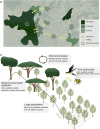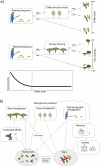Lessons from Ethiopian coffee landscapes for global conservation in a post-wild world
- PMID: 38858451
- PMCID: PMC11164958
- DOI: 10.1038/s42003-024-06381-5
Lessons from Ethiopian coffee landscapes for global conservation in a post-wild world
Abstract
The reality for conservation of biodiversity across our planet is that all ecosystems are modified by humans in some way or another. Thus, biodiversity conservation needs to be implemented in multifunctional landscapes. In this paper we use a fascinating coffee-dominated landscape in southwest Ethiopia as our lens to derive general lessons for biodiversity conservation in a post-wild world. Considering a hierarchy of scales from genes to multi-species interactions and social-ecological system contexts, we focus on (i) threats to the genetic diversity of crop wild relatives, (ii) the mechanisms behind trade-offs between biodiversity and agricultural yields, (iii) underexplored species interactions suppressing pest and disease levels, (iv) how the interactions of climate change and land-use change sometimes provide opportunities for restoration, and finally, (v) how to work closely with stakeholders to identify scenarios for sustainable development. The story on how the ecology and evolution of coffee within its indigenous distribution shape biodiversity conservation from genes to social-ecological systems can inspire us to view other landscapes with fresh eyes. The ubiquitous presence of human-nature interactions demands proactive, creative solutions to foster biodiversity conservation not only in remote protected areas but across entire landscapes inhabited by people.
© 2024. The Author(s).
Conflict of interest statement
All authors declare no competing interests.
Figures





Similar articles
-
Effects of coffee management on deforestation rates and forest integrity.Conserv Biol. 2013 Oct;27(5):1031-40. doi: 10.1111/cobi.12079. Epub 2013 Jun 14. Conserv Biol. 2013. PMID: 23772911
-
Biodiversity conservation in agricultural landscapes: challenges and opportunities of coffee agroforests in the Western Ghats, India.Conserv Biol. 2010 Apr;24(2):479-88. doi: 10.1111/j.1523-1739.2009.01386.x. Epub 2009 Dec 16. Conserv Biol. 2010. PMID: 20028413
-
Ecology, evolution, and conservation of Ethiopia's biodiversity.Proc Natl Acad Sci U S A. 2022 Dec 13;119(50):e2206635119. doi: 10.1073/pnas.2206635119. Epub 2022 Dec 9. Proc Natl Acad Sci U S A. 2022. PMID: 36490314 Free PMC article.
-
Agricultural wilding: rewilding for agricultural landscapes through an increase in wild productive systems.J Environ Manage. 2021 Apr 15;284:112050. doi: 10.1016/j.jenvman.2021.112050. Epub 2021 Feb 11. J Environ Manage. 2021. PMID: 33582481 Review.
-
[Landscape planning approaches for biodiversity conservation in agriculture].Ying Yong Sheng Tai Xue Bao. 2008 Nov;19(11):2538-43. Ying Yong Sheng Tai Xue Bao. 2008. PMID: 19238860 Review. Chinese.
References
-
- Ellis EC, Ramankutty N. Putting people in the map: anthropogenic biomes of the world. Front. Ecol. Environ. 2008;6:439–447. doi: 10.1890/070062. - DOI
Publication types
MeSH terms
Substances
Grants and funding
- VR2015-03600/Vetenskapsrådet (Swedish Research Council)
- VR2019-04493/Vetenskapsrådet (Swedish Research Council)
- SWE-2009-134/Styrelsen för Internationellt Utvecklingssamarbete (Swedish International Development Cooperation Agency)
- Project ID 614278/EC | EC Seventh Framework Programm | FP7 Ideas: European Research Council (FP7-IDEAS-ERC - Specific Programme: "Ideas" Implementing the Seventh Framework Programme of the European Community for Research, Technological Development and Demonstration Activities (2007 to 2013))
LinkOut - more resources
Full Text Sources

